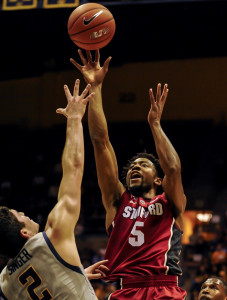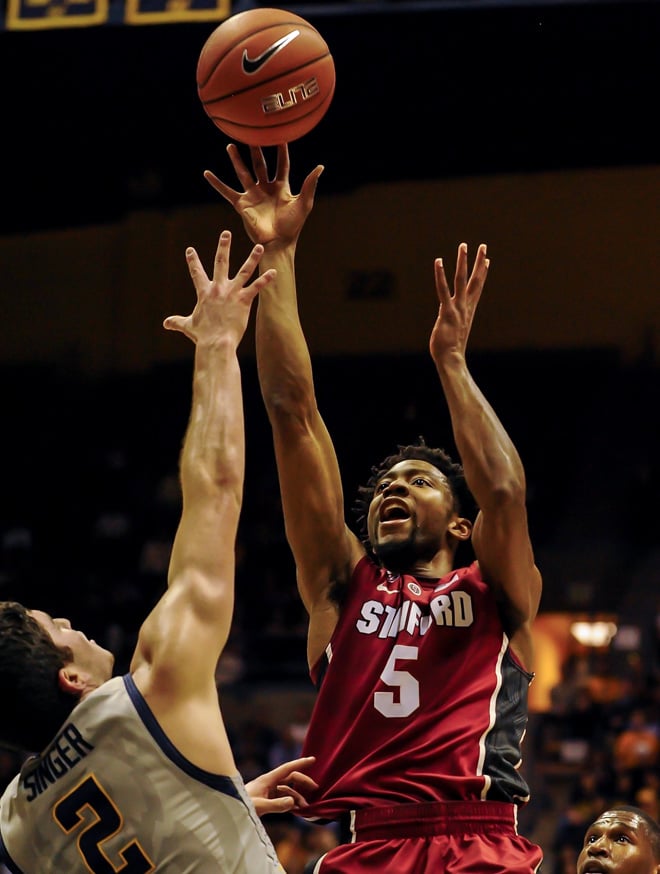Stanford’s men’s basketball team lost last Saturday to Washington State, a team against which it was heavily favored. This is the second time this season that Stanford has fallen to an opponent of far lower RPI, the first being DePaul on Nov. 30. We asked basketball writers Irving Rodriguez, Sandip Srinivas and Andrew Mather: What factors have limited Stanford’s performance and contributed to these disappointing defeats? What steps must the Cardinal take to avoid these losses going forward?
Irving: Four of Stanford’s five losses thus far have all been winnable games (the loss against Duke is another story). DePaul was up 41-30 at half, but the Blue Demons never seemed to be in control of the game. They pulled away in the second half only because Stanford played its worst game all season.

The BYU game was a 2-point loss in which the Cardinal gave up 15 offensive rebounds, good for 25 second-chance points.
The double-OT game at UCLA saw a 14-point lead wither away in the last 10 minutes. A dominant performance in the paint from Kevon Looney and Tony Parker resulted in a 19-3 run and 49 total points for the two big men.
The Arizona game came down to a few bad possessions in an otherwise superb game for the Cardinal.
Que Johnson pioneered a 17-3 run for Washington State that erased a 27-14 Stanford lead. DaVonte Lacy’s hot hand helped the Cougars edge out a close victory.
I’ll preface my analysis by saying this: Basketball is not a game of general narratives. The devil is always in the details and the outcome of a game is determined by a string of dependent events — not necessarily by one (or a few) reason(s).
That being said, the defense in key spans of Stanford’s losses has been the team’s downfall. The fault is not in individual effort: Anthony Brown can shut down nearly any opposing wing, Chasson Randle and Marcus Allen will make it difficult for any quick guard to score and Stefan Nastic protects the rim well against guards and bigs alike.
However, the Cardinal have trouble reacting to dribble penetration and at times is late in rotating from the weak side. DaVonte Lacy played the pick-and-roll against Stanford beautifully; on one play in the first half, he got to the free-throw line off a screen from Que Johnson. Rosco Allen was on a shooter and Anthony Brown was late to step in front of Lacy, resulting in a free dunk.
Late rotations like these lead to easy looks around the rim and leave open bodies for offensive rebounds. Teams can score 8, 12, 14 points in a couple minutes when you pile up enough of these possessions, which is what has happened thus far in Stanford’s losses.
The Cardinal have plenty of games left to iron out the kinks in this sporadically porous defense. Next month, a minute and a half of this lackluster intensity can easily put a game out of reach. A handful of games with a strong defensive effort for a full 40 minutes should establish enough continuity for a successful March.
Andrew: Much of the onus for these losses falls on Johnny Dawkins and his unwillingness to tweak his offensive model. Dawkins seems to live and die by his starters in both his victories and his defeats, and that can neglect some of the potential for Stanford’s developing bench to make an impact on the game.
Looking back to Saturday night, it appeared for many parts of the game that it was Chasson Randle against the world — or at least whatever fraction thereof happened to be in Pullman. In reality, however, the Cardinal had a number of players who performed extremely well but just didn’t see much action.
Dorian Pickens scored 80 percent of Anthony Brown’s point total on 2-for-3 shooting. Michael Humphrey matched or topped Nastic in every major statistic except for points scored, and he showed he was as clutch as anyone in the stadium when he came up with a huge block near the end of the second half to keep Stanford in the game. Reid Travis pulled in two offensive rebounds in his first game back from injury, as many as anyone else on the court. Yet Randle and Brown recorded more minutes individually than these three players combined, and that number assuredly would have been higher had Nastic not spent a large amount of time on the bench because of foul trouble.
Obviously it is important for Dawkins to give his playmakers a chance to win games. But I have to wonder if maybe, just maybe, somebody else might have had the energy or the touch in these tough losses to help give Stanford a little boost along the way.
Sandip: Having three star players carry a team is a double-edged sword. On one hand, there are games where all three players are playing great together, which, thankfully, Stanford has gotten from Randle, Brown and Nastic on many nights. However, there are games like Saturday night’s against Washington State in which the onus is put on one of the three players, and it’s not enough for Stanford to get the job done.
Now, this isn’t meant to place the blame for the one-point losses on Nastic and Brown. Nastic may have gotten into early foul trouble, something he’s done a great job avoiding this year, and Brown may have uncharacteristically struggled with shooting (2-of-11 from the field), but the problem extends beyond that.
Dawkins needs to devise some offensive sets that don’t entirely revolve around Randle. Whether this means allowing role players Rosco Allen and Marcus Allen more opportunities on the ball, Stanford has to find ways to be more than a one-trick pony on nights where some of their stars may be struggling. The secondary lineups need to do a better job of limiting the damage, and only then will Stanford be be competitive for a full 40 minutes.
Contact Irving Rodriguez at irodriguez ‘at’ stanford.edu, Andrew Mather at amather ‘at’ stanford.edu and Sandip Srinivas at sandips ‘at’ stanford.edu.
